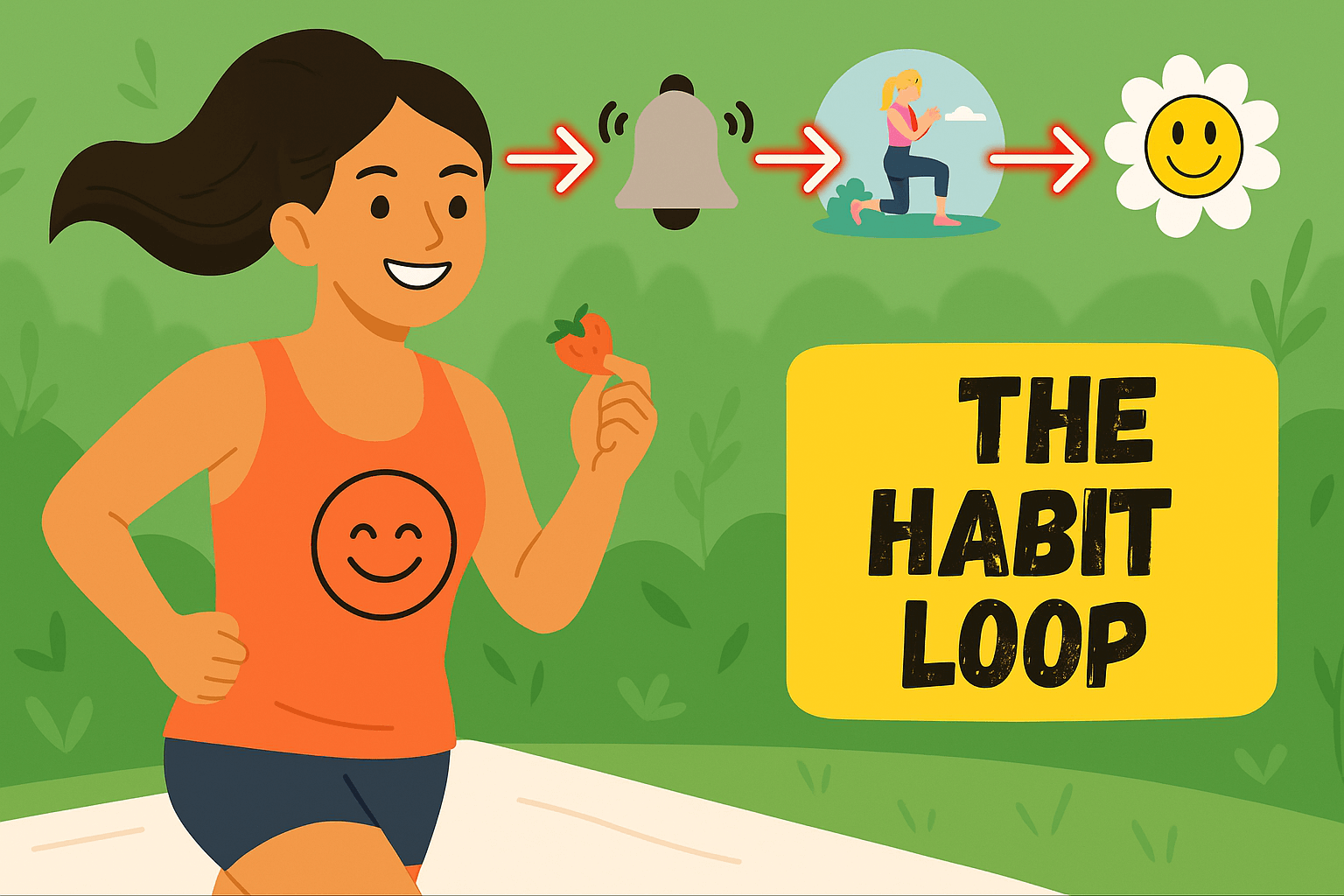The Habit Loop: Understanding the Science Behind Habit Formation
Have you ever wondered why certain behaviours like snacking mindlessly or skipping a morning workout—are so hard to change, while others, such as brushing your teeth or putting on a seatbelt, happen almost automatically? The answer lies in the “habit loop,” a well-documented concept in behavioural science that explains how habits are formed and maintained. When we understand the cues, routines, and rewards that drive our actions, it becomes easier to establish healthier habits and break unhelpful ones.
Recent research, including a randomized controlled trial on “Nudging while online grocery shopping” published in Appetite, suggests that small shifts in how we present or perceive choices (sometimes known as “nudges”) can significantly influence our behaviour. These findings mirror the habit-loop framework, which focuses on altering the triggers for our routines and ensuring the rewards are more aligned with our goals.
In this article, we’ll delve into the science behind the habit loop, explore why it’s such an effective tool for building healthy habits, and examine practical techniques you can start using today. Along the way, we’ll reference insights from leading experts, research studies, and real-life examples. Whether your aim is to adopt better eating habits, be more active, or simply feel in greater control of your daily life, understanding the habit loop is a solid first step toward lasting change.
DEFINING THE HABIT LOOP
The habit loop is most often described as a cycle of three key elements: cue, routine, and reward. While authors like Charles Duhigg helped popularise this framework, similar models have appeared in behavioural psychology for decades.
Let’s break down each component:
Cue (Trigger): A cue is any internal or external stimulus that initiates the behaviour. This might be a time of day, an emotional state, a location, or even the presence of certain people. For instance, hearing a work break bell may prompt you to grab a snack.
Routine (Behaviour): The routine is the action or series of actions that follow the cue. It can be a physical act (like opening the fridge and taking out a slice of cake) or a mental one (like scrolling social media whenever you feel bored).
Reward (Outcome): Finally, the reward is what reinforces the behaviour so that it becomes more likely to occur again. This could be a sense of pleasure, relief, or satisfaction—anything that your brain perceives as a positive outcome, thus “closing the loop.”
Over time, as you repeat the sequence (cue → routine → reward), the behaviour becomes automatic, requiring less and less conscious decision-making. Eventually, the presence of the cue itself is enough to trigger the entire routine.
THE SCIENCE OF HABIT FORMATION
Why do some habits develop so quickly while others never seem to stick? The answer lies in both psychological and neurological factors:
Repetition and Reinforcement, Every time you complete the loop, neural pathways in your brain become more robust. Repetition strengthens these pathways, just like exercise strengthens a muscle.
Dopamine and Pleasure When you experience a reward—be it the taste of food, the relief from stress, or a burst of energy—your brain releases dopamine, which helps you remember and crave that experience again.
Craving and Anticipation According to habit expert James Clear, craving often plays a pivotal role in turning a one-time behaviour into a recurring habit. Once the brain recognises a cue and associates it with a reward, you begin anticipating that reward whenever the cue appears.
Cognitive Biases and Automaticity.Cognitive biases mental shortcuts that help us process information quickly protect existing habits from scrutiny. For example, the status quo bias keeps us repeating familiar routines without evaluating their benefits or drawbacks.
CONNECTING NUDGING RESEARCH & THE HABIT LOOP
In the context of building healthy habits, subtle environmental changes or “nudges” can be highly effective. A study on online grocery-shopping interventions investigated how rearranging the digital environment (e.g., displaying healthier products first) influenced consumer behaviour. The principle here is closely aligned with the habit loop:
Modify the Cue:
When healthier items appear prominently on your screen or are labelled as “Recommended,” shoppers see a new cue that can trigger a different routine purchasing more nutrient-dense foods.Routine Shift:
With the cue changed, the routine (i.e., your act of placing items into the online basket) adapts. For instance, you might automatically click on fresh fruit suggestions rather than biscuits.Reward Realignment:
If these new choices lead to a positive outcome like feeling lighter, having more energy, or staying within a budget your brain interprets it as a reward and is more likely to repeat the behaviour.
These findings highlight how relatively minor adjustments to cues can recalibrate entire routines, supporting healthier eating behaviours without requiring people to rely solely on willpower or conscious deliberation. Because habits are often driven by nonconscious processes, this nudge-based approach neatly aligns with “habit loop” theory.
STRATEGIES FOR BUILDING HEALTHY HABITS USING THE HABIT LOOP
Below are some practical techniques for applying the habit loop model to cultivate and maintain healthy habits:
Identify Existing Cues Take note of the times, places, and emotional states that typically precede an unwanted habit. If you want to reduce late-night snacking, observe how you feel just before you reach for crisps at 10 p.m. Are you stressed, bored, or simply used to watching TV with a snack in hand?
Insert a New Routine Once you’ve identified a cue, consider replacing the current routine with something healthier. In the snacking scenario, try substituting crisps with herbal tea or reading a book instead of heading straight to the kitchen. The cue (time of day, stress level) remains the same, but you’re intentionally swapping in a new routine.
Ensure a Reward Aligns with Your Goals For a healthier habit to stick, it must still deliver some form of reward. This could be tangible like making yourself a tasty fruit smoothie, which is both delicious and healthful—or intangible, like the satisfaction of ticking off a habit tracker. Whichever reward you choose, it needs to resonate with you personally.
Use Environmental Nudges Research on online grocery-shopping interventions (sciencedirect.com) demonstrates how adjusting cues in your environment can nudge behaviour. Try rearranging your pantry so that healthy, whole foods are at eye level, while sugary snacks are stowed away. Or keep a water bottle on your desk as a visual trigger to stay hydrated.
Start Small and Build Gradually. Overhauling multiple habits at once can be overwhelming. Instead, focus on a single, manageable change. If your goal is “eat more vegetables,” begin with adding one extra serving of greens to your dinner. As that becomes automatic, layer in the next habit shift e.g., switching crisps for carrot sticks at lunchtime.
Track Your Progress: Monitoring how often you repeat a new habit even using a simple tally or checklist can help you stay accountable. According to habit research, immediate feedback helps reinforce behavioural change.
Plan For Obstacles Real-life conditions like busy schedules, mood swings, or social events can derail even the most well-intentioned routine. If you know you’ll be short on time, prepare a healthy snack the night before. Anticipating and planning for challenges helps ensure your new habit stays intact.
OVERCOMING COGNITIVE BIASES WITH THE HABIT LOOP
Even with a solid habit loop in mind, mental shortcuts can sabotage our best efforts. Here’s how to work around common biases:
Status Quo Bias: You might feel tempted to default to old habits (like bedtime scrolling) simply because they’re comfortable. To counter this, make your desired routine even easier. If your new habit is reading before bed, place a good book on your pillow so that skipping it is harder than picking it up.
Confirmation Bias: If you believe you’re “just not a morning person,” you may dismiss evidence to the contrary. Track your mornings throughout the week, marking which days you actually got up earlier and felt more productive. Let real data guide you rather than preconceived notions.
Overconfidence Bias: You might assume you can adopt five new habits at once without any slip-ups. In reality, change takes time and perseverance. Commit to one or two habits at a time, and celebrate incremental wins.
Loss Aversion: Many people fear giving up habits that bring short-term pleasure like sweets after dinner in exchange for long-term health. Reframe the new routine as a gain: for instance, remind yourself you’ll enjoy more sustained energy and fewer sugar crashes, which can feel better than a fleeting sugar high.
REAL-LIFE EXAMPLE: HEALTHIER ONLINE SHOPPING
Imagine you do your weekly grocery shopping online every Sunday. Usually, you end up ordering a variety of snacks—chocolates, crisps, and fizzy drinks—because they’re suggested on the site’s homepage under “Favourites.” Here’s how you could apply the habit loop concept to instil a healthier routine:
Cue: Sunday morning online grocery session.
Routine: Instead of clicking on your “Favourites,” scroll across to the “Fresh Produce” or “Healthy Choices” section first.
Reward: After finalising the order, reward yourself with something that’s not food-related, like spending 10 minutes reading a novel, watching a short comedy clip, or listening to a favourite song.
Over time, choosing fruit and vegetable options can become just as automatic as adding crisps once was—especially if the online platform “nudges” these healthier items to appear prominently. This example parallels the findings in “Nudging while online grocery shopping”: making the healthier choice simpler or more visible can shift your default sequence of decisions.
CONCLUSION
The habit loop—cue, routine, and reward—offers a powerful lens through which we can understand our daily behaviours and influence them toward healthier outcomes. By identifying the cues that trigger your actions, consciously selecting a routine aligned with your wellness goals, and ensuring the routine yields a meaningful reward, you can reshape ingrained patterns that once felt beyond your control.
Research on “nudges” including the online grocery-shopping RCT highlights the effectiveness of altering cues in the environment to guide behaviour change subtly but significantly. Combined with your own commitment to consistent repetition, small habit shifts can accumulate into transformative results—whether you want to improve your diet, gain more energy, or simply live a healthier, more balanced life.




